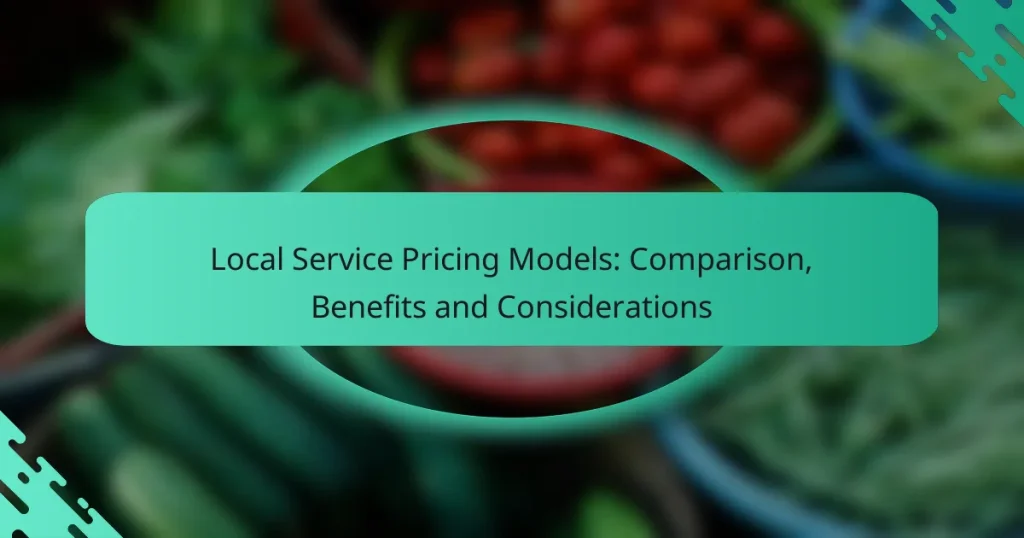Local services employ a variety of pricing models, such as hourly rates, flat fees, and subscriptions, each with unique benefits and considerations for both providers and customers. By examining these models, businesses can better navigate market demands and regional economic conditions, ultimately selecting strategies that enhance profitability and customer satisfaction.

What are the common pricing models for local services?
Local services typically utilize several pricing models to determine costs. These models include hourly rates, flat fees, subscriptions, tiered pricing, and pay-per-use, each offering distinct advantages and considerations for both service providers and customers.
Hourly rate pricing
Hourly rate pricing charges clients based on the actual time spent on a service. This model is common in fields like consulting, home repairs, and personal training, where the duration of service can vary significantly.
When using hourly rates, it’s crucial to communicate estimated hours upfront to avoid misunderstandings. Rates can vary widely, often ranging from $25 to $150 per hour, depending on the service type and local market conditions.
Flat fee pricing
Flat fee pricing involves a fixed charge for a specific service, regardless of the time taken. This model is often used for services like plumbing repairs or lawn care, where the scope of work is well-defined.
Flat fees provide clients with clarity on costs, eliminating surprises. It’s essential to ensure that the service scope is clearly outlined to avoid scope creep, which can lead to dissatisfaction for both parties.
Subscription pricing
Subscription pricing allows clients to pay a recurring fee for ongoing services, such as monthly cleaning or maintenance. This model is beneficial for services that require regular attention and can foster long-term relationships.
Subscriptions can offer savings compared to one-time fees and ensure consistent service delivery. Providers should consider offering different subscription tiers to cater to varying client needs and budgets.
Tiered pricing
Tiered pricing offers multiple service levels at different price points, allowing clients to choose based on their needs and budget. This model is common in industries like fitness, where clients can select from basic to premium memberships.
Each tier typically includes a different set of features or services, making it easier for clients to find a suitable option. Clear communication about what each tier includes is vital to avoid confusion and ensure customer satisfaction.
Pay-per-use pricing
Pay-per-use pricing charges clients based on their actual usage of a service, making it ideal for services like car rentals or storage units. This model allows clients to pay only for what they need, which can be cost-effective for infrequent users.
While this model offers flexibility, it can lead to unpredictable costs for clients. Providers should ensure transparent pricing structures and consider offering estimates based on typical usage patterns to help clients budget effectively.

How do local service pricing models compare?
Local service pricing models vary significantly based on factors such as service type, market demand, and regional economic conditions. Understanding these differences helps businesses choose the most suitable pricing strategy to maximize profitability and customer satisfaction.
Cost-effectiveness analysis
Cost-effectiveness analysis involves evaluating the total costs associated with different pricing models against the benefits they provide. For instance, fixed pricing may offer predictability, while hourly rates can be more economical for variable workloads. Businesses should assess their operational costs and customer preferences to determine which model yields the best return on investment.
Consider conducting a break-even analysis to identify the minimum service volume needed to cover costs under each pricing model. This can help in making informed decisions about pricing strategies that align with financial goals.
Flexibility and scalability
Flexibility in pricing models allows businesses to adapt to changing market conditions and customer needs. For example, subscription-based models can provide steady revenue while allowing customers to scale services up or down based on their requirements. This adaptability can be crucial in competitive markets where customer preferences shift frequently.
Scalability is essential for growth; businesses should choose pricing models that can easily accommodate an increase in service demand without significant restructuring. For instance, tiered pricing can incentivize larger purchases while maintaining profitability across different customer segments.
Market competitiveness
Market competitiveness is influenced by how local service pricing models align with customer expectations and competitor offerings. Understanding local pricing trends can help businesses position themselves effectively. For example, if competitors predominantly use hourly rates, adopting a flat fee might attract price-sensitive customers.
Regularly reviewing competitor pricing and adjusting your strategy accordingly can enhance market positioning. Utilizing promotional pricing or bundling services can also provide a competitive edge, especially in saturated markets.

What are the benefits of different pricing models?
Different pricing models offer various benefits that can significantly impact a business’s financial health and customer satisfaction. Understanding these advantages helps businesses choose the right model to optimize revenue and enhance client relationships.
Predictable revenue streams
Pricing models such as subscriptions or retainers create predictable revenue streams, allowing businesses to forecast income more accurately. This stability is crucial for budgeting and planning future investments.
For example, a service provider charging a monthly fee can anticipate their earnings for the upcoming months, reducing financial uncertainty. This predictability can also attract investors looking for stable returns.
Customer retention strategies
Implementing specific pricing models can enhance customer retention by fostering loyalty and long-term relationships. Subscription services, for instance, encourage customers to commit for extended periods, often leading to higher lifetime value.
Offering discounts for long-term contracts or bundling services can further incentivize customers to stay. Businesses should consider tailoring their pricing strategies to meet customer needs and preferences to maximize retention.
Enhanced service delivery
Different pricing models can improve service delivery by aligning revenue with customer satisfaction. For instance, performance-based pricing ties a portion of fees to the results delivered, motivating service providers to excel.
This approach not only enhances the quality of service but also builds trust with clients, as they see a direct correlation between their investment and the outcomes achieved. Businesses should regularly evaluate their pricing strategies to ensure they support optimal service delivery.

What considerations should be made when choosing a pricing model?
When selecting a pricing model for local services, it’s essential to consider factors such as target audience demographics, service complexity, and current market trends. Each of these elements can significantly influence the effectiveness and profitability of the chosen model.
Target audience demographics
Understanding your target audience demographics is crucial when determining a pricing model. Factors such as age, income level, and location can affect how much customers are willing to pay for services. For instance, a younger demographic may prefer subscription-based models, while older clients might favor straightforward hourly rates.
Conducting market research can help identify the specific needs and preferences of your audience. Surveys and focus groups can provide insights into pricing sensitivity and service expectations, allowing you to tailor your offerings accordingly.
Service complexity
The complexity of the services offered plays a significant role in pricing model selection. More intricate services may justify higher rates or a tiered pricing structure, while simpler services might be better suited to flat fees. For example, a plumbing service that requires specialized skills may charge more than a basic cleaning service.
Consider breaking down services into packages or tiers based on complexity. This approach allows clients to choose options that fit their needs and budgets, enhancing customer satisfaction and retention.
Market trends in local services
Staying informed about market trends in local services is vital for selecting an effective pricing model. Trends such as the rise of on-demand services or the popularity of digital platforms can influence customer expectations and pricing strategies. For instance, many consumers now expect transparent pricing and instant quotes.
Regularly analyze competitors and industry reports to adapt your pricing model to current market conditions. This may involve adjusting rates, offering promotions, or exploring new service delivery methods to remain competitive and appealing to your target audience.

How do local regulations affect pricing models?
Local regulations significantly influence pricing models by imposing various costs and compliance requirements that businesses must account for. Understanding these regulations helps businesses set competitive prices while ensuring legal adherence.
Licensing and permit costs
Licensing and permit costs can vary widely depending on the industry and location. For example, a construction business may face fees ranging from a few hundred to several thousand dollars for necessary permits, while a food service establishment might incur lower costs but still needs multiple licenses.
These costs should be factored into the overall pricing strategy. Businesses should research local requirements early in their planning process to avoid unexpected expenses that could affect profitability.
Compliance with local laws
Compliance with local laws often involves adhering to health, safety, and environmental regulations, which can add to operational costs. For instance, businesses in the hospitality sector must comply with health codes that require regular inspections, potentially leading to increased operational overhead.
To manage compliance costs effectively, businesses should stay informed about local regulations and consider consulting with legal experts. Regular training for staff on compliance issues can also help mitigate risks and avoid costly fines.


